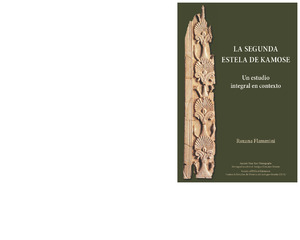Please use this identifier to cite or link to this item:
https://repositorio.uca.edu.ar/handle/123456789/19780| Título: | La segunda estela de Kamose. Un estudio integral en contexto | Autor: | Flammini, Roxana | Palabras clave: | ANTIGUO EGIPTO; Kamose | Fecha de publicación: | 2025 | Editorial: | Society of Biblical Literature Pontificia Universidad Católica Argentina. Centro de Estudios de Historia del Antiguo Oriente |
Resumen: | The Second Stela of Kamose (K2) is a fundamental document for understanding the final phase of the Second Intermediate Period in Egypt with an approximate dating of ca. 1550 BCE. K2 is part of a documentary corpus along with two other stelae attributed to Kamose, found in the temple of Amun at Karnak. It was discovered in 1954 at the base of a colossal statue of Ramesses II during restoration work on the temple’s second pylon. This discovery provided access to a text in excellent condition, though it does exhibit some damage, such as the loss of the upper right part of the lunette. Since its discovery, K2 has been extensively studied, particularly following the publication of the editio princeps in 1972 by Labib Habachi, titled “The Second Stela of Kamose and His Struggle against the Hyksos Ruler and His Capital.” Most studies on K2 have focused on linguistic and narrative analysis, mainly in English, with limited dissemination in German, French, and Spanish. This highlights the need for new approaches to the document, including a translation into Spanish and an interpretation that incorporates the figurative value of Egyptian writing. Additionally, it is crucial to study the physical support of the stela and the traces of social practices it has received, such as the damnatio memoriae applied to proper names and the presence of graffiti— aspects mentioned by Habachi but overshadowed in favor of textual analysis. This study does not exhaustively compare K2 and the First Stela of Kamose (K1) or its hieratic copy, the Carnarvon Tablet (TIC), except when strictly necessary. Due to its fragmentary condition, the Third Stela of Kamose (K3) does not provide relevant information to our goals. Thus, instead of focusing solely on the narrative, this research adopts a broader perspective that includes the materiality of the stela, the cultural imprints it has received, and its significance within the historical and archaeological context. K2’s text consists of thirty-eight lines, with signs oriented to the right. The first line begins in the middle of a sentence, suggesting the existence of a missing first part yet to be discovered. For analysis, the content has been organized into three main sections: (1) the lunette; (2) the text, divided into four thematic sections; and (3) the representation of the overseer of sealed things, User-Neshemet (Neshi), and the accompanying inscription. The first thematic section (lines 1–18) is dominated by Kamose’s voice, recounting his actions against the Hyksos and describing the personality of the Hyksos ruler Apepi. Kamose alternates between the third person as a narrator and the first-person singular to emphasize his decisions and perceptions. This part of the text highlights his active role in the struggle against the Hyksos and reinforces his leadership image. The second thematic section (lines 18–30) describes the interception of a letter sent by Apepi to the ruler of Kush, whose name is not mentioned. The letter is quoted “textually” but adapted to Egyptian decorum norms. Additionally, military actions are mentioned in territories near Hyksos domains, including the dmj and the territory-djat of Avaris, as well as campaigns in Cynopolis and the Bahariya Oasis. Localities such as Hermopolis and Gebelein are also mentioned, suggesting the geographical breadth of the events described. The third thematic section (lines 30–35) narrates Kamose’s return to Thebes after his victories and the performance of rituals in the temple of Amun. This segment reinforces the connection between royal power and the divine, consolidating Kamose’s image as a legitimate ruler favored by the gods. Finally, the fourth thematic section (lines 36–38) details Kamose’s order to User-Neshemet for the creation and placement of the stela in Karnak. This passage underscores the importance of written records as a tool for legitimizing power and communicating the king’s achievements to future generations. To facilitate analysis, photographs of the original stela have been used, complemented by a digital hieroglyphic version created with JSesh software (version 7.5.5.), including reconstructions in damaged sections. The text is provided in transliteration, along with detailed information on each term and its translation. The identification of terms follows the Thesaurus Linguae Aegyptiae (TLA) proposal, enabling access to complete lexical information through an online database. Additionally, comments explore the figurative value of certain signs, highlighting the scribe’s choice and their impact on text interpretation. Beyond the text, the study analyzes the representation of the official User-Neshemet, located at the lower left part of the stela. His iconography, name, and function title—inscribed in a column next to his figure—are examined. This analysis provides a better understanding of the administrative hierarchy and key figures in Kamose’s narrative. Another crucial aspect is the study of the cultural imprints left on the stela over time. Cases of damnatio memoriae are documented, in which proper names were deliberately erased as part of political strategies, possibly during the Amarna period. The graffiti inscribed on the stela are also analyzed, offering insights into how the monument was perceived in different historical periods. In conclusion, this new approach to the Second Stela of Kamose seeks to transcend a strictly narrative analysis by integrating the study of its physical support, subsequent modifications, and the visual elements of Egyptian writing. This perspective offers a fresh view on K2, emphasizing its importance as a historical source and a material object with a significant cultural trajectory. This research offers a contribution that complements and expands previous studies, providing new insights into a key text for the history of ancient Egypt. | URI: | https://repositorio.uca.edu.ar/handle/123456789/19780 | ISBN: | 9781628376531 | Derechos: | Atribución-NoComercial-CompartirIgual 4.0 Internacional | Fuente: | Flammini, R. La segunda estela de Kamose. Un estudio integral en contexto. Society of Biblical Literature; Pontificia Universidad Católica Argentina. Centro de Estudios de Historia del Antiguo Oriente, 2025 |
| Appears in Collections: | Series monográficas |
Files in This Item:
| File | Description | Size | Format | |
|---|---|---|---|---|
| segunda-estela-kamose.pdf | 11,68 MB | Adobe PDF |  View/Open |
This item is licensed under a Creative Commons License

